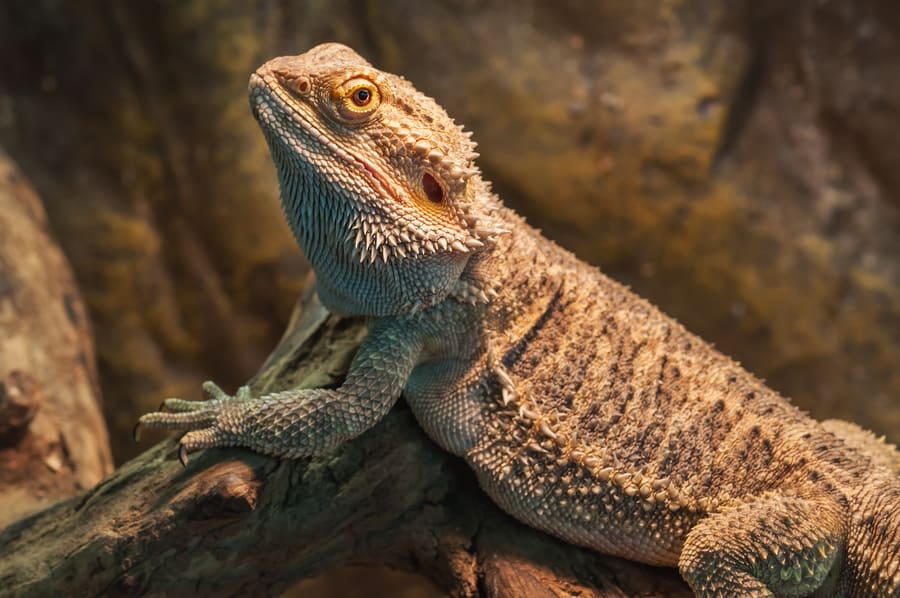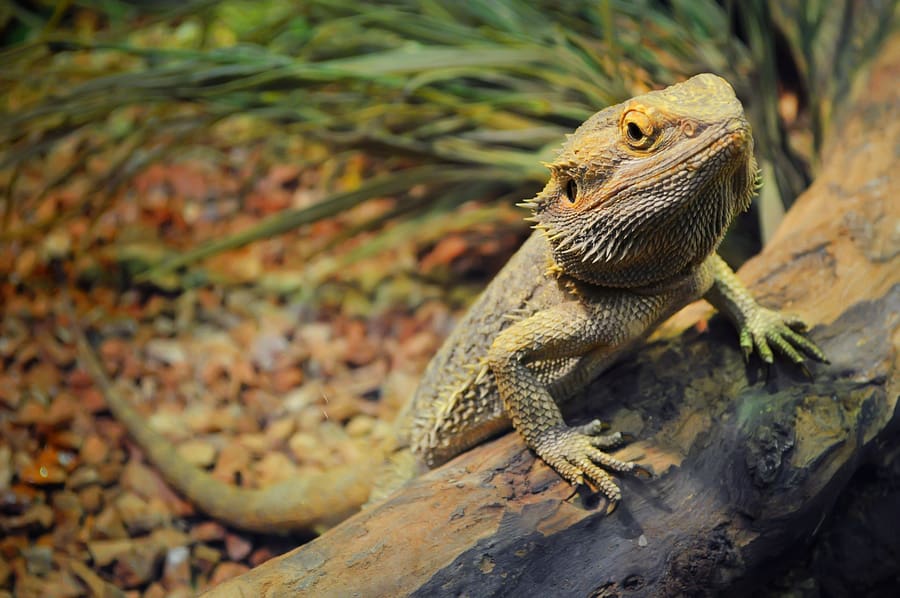
If you have a bearded dragon and dog, you might be considering whether you should allow them to interact with one another. Bearded dragons tend to be fairly docile creatures, and dogs are typically friendly animals. However, you may also be concerned with risks such as an unexpected attack, heightened stress levels, or spread of disease.
There is some inherent risk when introducing a dog and bearded dragon such as disease spread, the dog attacking the bearded dragon, or stress but a gradual introduction and watching for red flags can make the process go smoothly. If matched well, a dog and bearded dragon can become friends.
Dogs and bearded dragons (and other pet reptiles) can coexist and even develop friendships. There are some concerns that need to be addressed, but it can be a great thing in the long run.
Dogs & Bearded Dragons
Reasons for Dog/Bearded Dragon Introduction
Because of their docile temperament, bearded dragons enjoy socializing with people and animals (not other bearded dragons). If they are a good match, your bearded dragon and dog will enjoy spending quality time with one another and possibly even play together. As long as the dog is gentle and the bearded dragon avoids stress, this will create a positive experience for both of them.
They also enjoy similar activities such as basking under the sun and taking a walk together. Bearded dragons can do very well on a leash. However, you should avoid bringing it to public places, as it can become more stressed, tired out, or even injured. Consider just walking them together around a small part of your yard. Also, even if they are in the sun, the room they are in will likely be cooler than their terrarium. Because of this, you should keep a watchful eye and return them to their terrarium if they appear cold.
Because of both the walking and playful activities they can do together, your pets will have the opportunity to exercise. This helps create mental stimulation as they explore together and enjoy a better quality of life.
Will My Dog Attack the Bearded Dragon?
In short, it depends on the dog and the situation. Because dogs have varying temperaments and personalities, they may either perceive a bearded dragon as a friend, just another creature, or a threat/tasty snack. If a dog feels threatened by the bearded dragon being in its territory, it may attack. This attack may include a bite, which can cause nerve damage in your bearded dragon from the length of the dog’s teeth. Because there is a strong risk of attacks in introducing your two pets, you should approach this with caution if you decide to do so.
A good way to predict how your dog will respond is by observing it while on a walk. Does it chase the squirrels, or does it simply ignore them? How does it respond to other dogs and cats that come near it? This will reveal your dog’s temperament and help you plan how you will have your dog interact with the bearded dragon.
Are Bearded Dragons Good with Dogs?
Generally, bearded dragons have fairly docile temperaments, so they are typically not aggressive. However, if they feel provoked, they may attack and even bite your dog. This is because the dog’s presence stresses out the bearded dragon, which can create a situation that escalates quickly. Also, a bearded dragon may become more aggressive if it is a male during mating season. During this time, both your bearded dragon and your dog should not be interacting with one another.
Even with these potential issues, however, your bearded dragon will likely do well if 1) the dog has a mild temperament and is fairly quiet, 2) you manage interactions to avoid unnecessary stress to your bearded dragon, and 3) you give both pets space and time alone in between interactions.
Age can also impact whether your bearded dragon will respond well. Because younger bearded dragons are less “set in their ways” and can develop long-term bonds more easily, they are more likely than adults to get along well with dogs. Dogs are the same way.
Some dog breeds may be more likely to get along with bearded dragons than others. For example, a Golden Retriever, Collie, Black Lab, or Great Dane may get along well with your bearded dragon because of their mild-mannered temperaments. However, a German Shepherd or Rottweiler is more likely to attack, forcefully play with, or eat your bearded dragon.
Also, noisier, more hyperactive breeds such as Chihuahuas may be less likely to cause harm, but their noisiness will result in stress. Even with this basic pattern, because dogs’ temperaments may widely vary even within the same breed, this is not a reliable guide.
How to Introduce Bearded Dragon to Dog
If you believe that your dog will get along well enough to introduce your bearded dragon to it, you should approach the meeting with strong caution and a watchful eye.
Before the introductory session, you should ensure that your dog is able to respond to commands, so you can call the dog away to keep the situation from escalating if needed. Also, you should strategically plan where you will arrange the meeting. To avoid perceptions of territorial threats, you should perform the introduction in a neutral area away from the bearded dragon’s terrarium and away from your dog’s most frequently visited area. Also, the room should be quiet, so both pets avoid experiencing unnecessary stress.
If it is possible, you should have both yourself and another person introduce the two pets. In this arrangement, one person can hold the dog on a leash and the other can carry the bearded dragon. This will ensure that both pets can be either protected or held back as needed.
During the introduction (and any future interactions if the introduction goes well), constantly watch the body language of both of your pets. If your dog is stiff and acts tense, or if the bearded dragon appears uneasy (a puffed-up and/or darkened beard is a strong indication), hold the animals back. If the issue seems to be escalating, bring the animals back to their own territory/terrarium. You may wait a few days and reintroduce them, but be sure to observe what caused the issue and work to keep it from happening again.
The meeting might not go so well the first time, but you can still alleviate the situation. For example, in the event that your dog starts acting aggressive, distracting it with a toy or telling it to come to a different area will prevent any escalation from happening. Also, do not punish your pets for appearing aggressive, stressed, or nervous. This will only create more tension between the two pets and may cause the dog to become frustrated and ignore your instructions. If you try to push your bearded dragon to interact because it appears nervous, it will be less likely to have a positive relationship with the dog. It may become stressed enough to lash out at either you or the dog.
Even if the introduction goes well, you should still supervise them when they are together at all times. Whether one of them perceives a territorial threat, the dog believes the bearded dragon might be a tasty meal, or the dog accidentally steps on the bearded dragon and starts a fight, you need to be in close proximity to avoid injury of either pet.
As your dog and bearded dragon continue to bond, you should always consider their time together as appointments that are carefully organized and supervised. They should not be allowed to be together all day with a few assigned rest breaks, and they certainly should not be together all of the time. This can increase the risk of one of them feeling threatened or an accidental injury from lack of supervision.

Will My Dog Eat My Bearded Dragon?
As mentioned before, your dog may eat your bearded dragon depending on its temperament. Dogs have deeply-ingrained predator instincts, which may be used against the bearded dragon. Also, they may bite the bearded dragon out of fear if they have never seen the bearded dragon before and find it foreign. If left unsupervised, they may eventually decide to eat the bearded dragon.
In particular, if you notice that your dog tends to treat squirrels and other small animals as prey, it will likely treat the bearded dragon the same way. Even if your dog seems fine during the introduction, it may simply avoid eating the bearded dragon while you are in the room and plan to attempt this act later on. Dogs have a strong desire to please their owners, and if they perceive that you are attached to your bearded dragon, they will avoid harming it in front of you.
Are Bearded Dragons Scared of Dogs?
Because bearded dragons are prey animals and smaller than dogs, your bearded dragon will likely be scared of it, even if it does not have an extreme reaction. Especially if your bearded dragon sees the dog walking around its cage, it will instinctively believe that the dog is a predator and trying to stalk it.
Because of this, you should never allow your dog around the bearded dragon’s terrarium, even if the two of them do well in a neutral space.
Also, if your dog tends to be loud and barks, your bearded dragon will become scared and stressed out. This is because it is very sensitive to noise and needs a quiet space. Finally, if the dog moves around a lot, especially during play, your bearded dragon may (reasonably) be afraid of getting crushed.
Regardless of the reason why your bearded dragon feels nervous, you should always keep a watchful eye and hold the dog back if it is beginning to stress the bearded dragon out. Although bearded dragons are mild-mannered, they may be driven to a flight or fight instinct and bite your dog if left unsupervised. If they bite the dog, they may spread disease.
Can Bearded Dragons Make My Dog Sick?
Unfortunately, bearded dragons can spread disease. For example, your bearded dragon may carry salmonella or parasites. If salmonella has spread to the dog, symptoms include diarrhea, lethargy, and vomiting. If your dog has contracted parasites, it will experience weight loss and potentially a potbelly along with the previously mentioned symptoms.
Also, if your bearded dragon bites your dog, it will inject a small amount of venom. Fortunately, this poison is not enough to harm a dog unless your dog has an allergic reaction (fortunately, this is uncommon). However, if you are introducing your bearded dragon to a puppy or unhealthy dog, it runs a larger risk of being harmed by the venom.
A very uncommon yet dangerous disease is botulism, which causes paralysis in both dogs and bearded dragons. It is most commonly spread through ingesting items, which is another reason why you should avoid having the dog near the terrarium. It may ingest some of the bearded dragon’s food if it is able to access the cage’s interior..
Bearded Dragons with Other Pets
Overall, bearded dragons tend to get along well with most pets. For example, they typically respond well to cats and enjoy spending time with them. In a way, cats may do better with bearded dragons than dogs. This is because cats are typically quieter animals, so they are less likely to cause the bearded dragon stress. Also, they are smaller, so they are less likely to unintentionally crush the bearded dragon.
However, they may view the bearded dragon’s acknowledgment of their presence, which consists of a wave (it can also be a sign of submission), to be a call to play. If you are not careful, your cat may injure your bearded dragon. Also, they still do have sharp claws and predator instincts.
Even with their ability to get along, bearded dragons should not be introduced to certain pets. For example, bearded dragons should not be introduced to mice, as they are likely to view them as prey. Also, bearded dragons tend to be quite territorial, so you should avoid allowing extended interactions with others of their kind.
